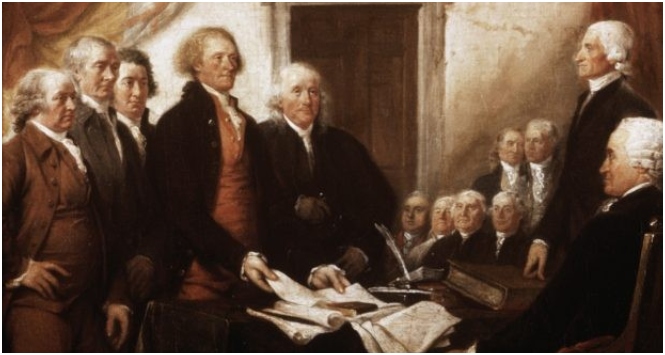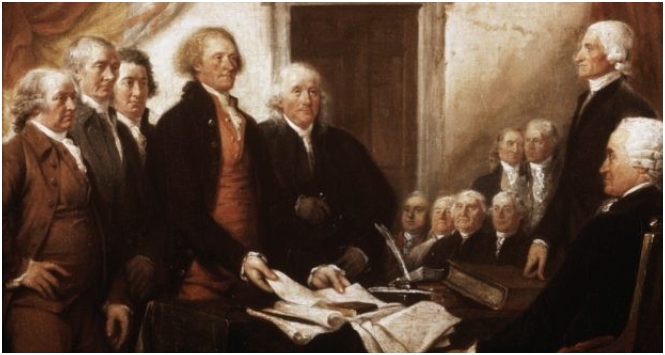While most Americans commemorate July 4th as Independence Day, marking the adoption of the Declaration of Independence by the Continental Congress, it was August 2, 1776, that truly sealed the birth of the nation in ink.
On this date, 56 delegates of the Second Continental Congress began formally signing the Declaration of Independence in Philadelphia’s State House, known today as Independence Hall—a move that solidified the colonies’ legal and philosophical break from Great Britain.
At the center of this pivotal moment stood John Hancock, the President of the Continental Congress, who was the first to sign and whose bold, sweeping signature became a symbol of revolutionary courage. His signature alone embodied the legal and personal risk these men undertook—committing an act of treason against the British Crown punishable by death.
A Legal Act of Rebellion

The signing of the Declaration was not merely ceremonial. It was a legal declaration of sovereignty, a public proclamation that the American colonies no longer recognized the legitimacy of British rule or Parliament’s authority over them. It laid out, in legal terms, the colonists’ right to “dissolve the political bands” connecting them to Britain and to assume “among the powers of the earth, the separate and equal station to which the Laws of Nature and of Nature’s God entitle them.”
Drafted primarily by Thomas Jefferson, with input from John Adams, Benjamin Franklin, Roger Sherman, and Robert R. Livingston, the Declaration is both a political document and a legal indictment. It catalogs a list of grievances against King George III, asserting that the monarch had violated the colonists’ rights under British constitutional law and natural law, effectively nullifying his legitimacy.
Why August 2 Matters Legally
Although July 4, 1776, marks the day the Continental Congress approved Jefferson’s draft, it wasn’t until August 2 that the engrossed copy—the official parchment version—was ready to be signed. This distinction matters for legal scholars and historians alike, as the act of signing converted the Declaration from a proposed resolution to a binding legal instrument.
Among legal circles, August 2 serves as a reminder that legitimacy in governance requires formal documentation, transparency, and consensus—all of which were represented in the public signing. It was not done in secret or imposed unilaterally but carried out by elected representatives acting in unison.
The Declaration’s Enduring Legal Impact
While the Declaration of Independence is not a governing document like the U.S. Constitution, it has nonetheless played a critical role in American legal thought:
- Natural Rights Doctrine: The Declaration enshrined the idea that all individuals are “endowed by their Creator with certain unalienable Rights,” laying the groundwork for later legal protections of life, liberty, and property.
- Due Process and Equal Protection: The statement that “all men are created equal” would later influence the 14th Amendment and be cited in landmark legal decisions like Brown v. Board of Education (1954).
- Originalism and Legal Interpretation: For constitutional originalists, the Declaration provides a philosophical and legal context for interpreting the Constitution, particularly regarding the Framers’ intent.
- Civil Rights Movement: Civil rights leaders, including Dr. Martin Luther King Jr., often invoked the Declaration as a “promissory note” that America had yet to fulfill for all its citizens.
Contemporary Reflections
In a time of political division and rising distrust in governmental institutions, the anniversary of the Declaration’s formal signing invites a reflection on what binds Americans together: a shared legal and moral foundation, grounded in liberty, representation, and the rule of law.
As we observe August 2, 2025, legal scholars, practitioners, and citizens alike are reminded of a time when law, philosophy, and political will aligned to produce one of the most consequential legal documents in human history.
Though centuries old, the Declaration of Independence remains an enduring symbol of lawful resistance, democratic aspiration, and moral courage—not just a relic of revolutionary rhetoric but a legal blueprint for challenging injustice in any era.
“We mutually pledge to each other our Lives, our Fortunes and our sacred Honor.”
— Final line of the Declaration of Independence, signed beginning August 2, 1776.

